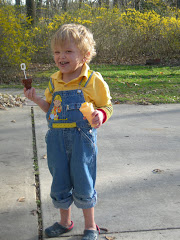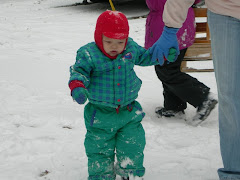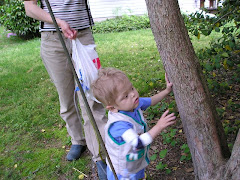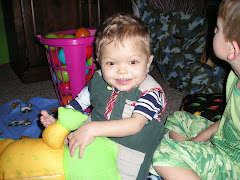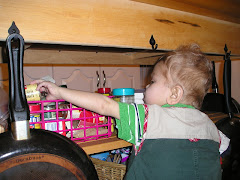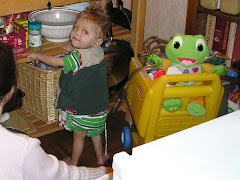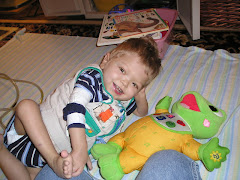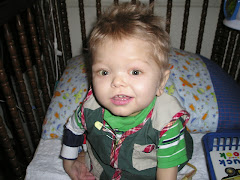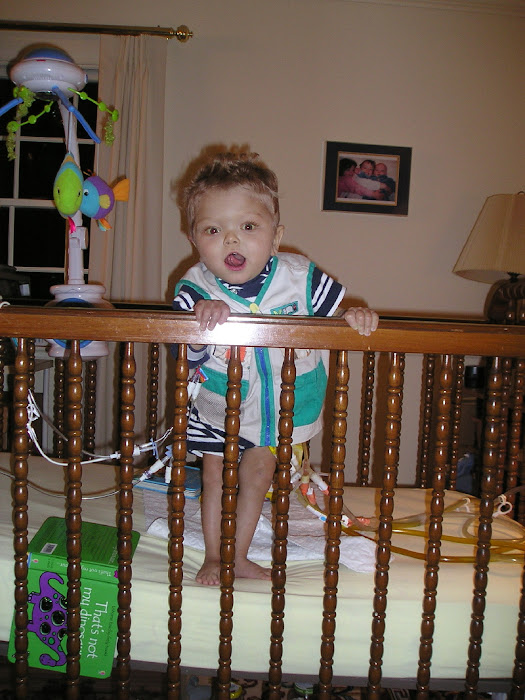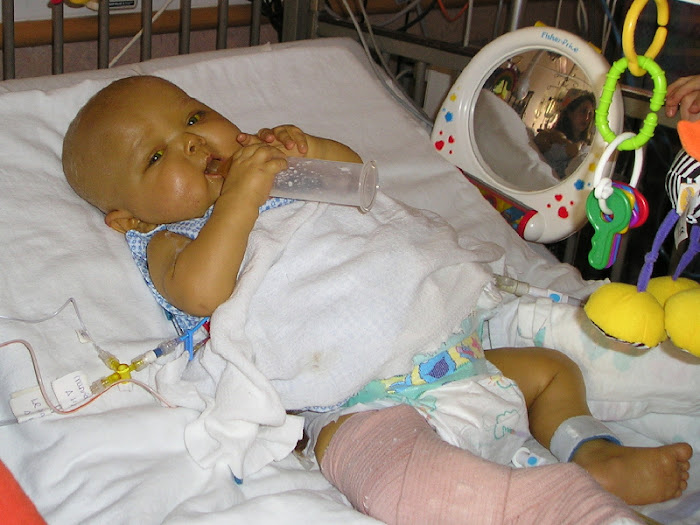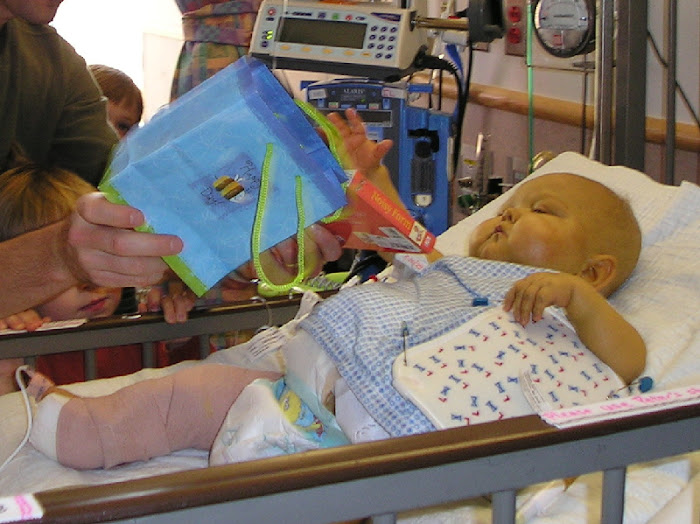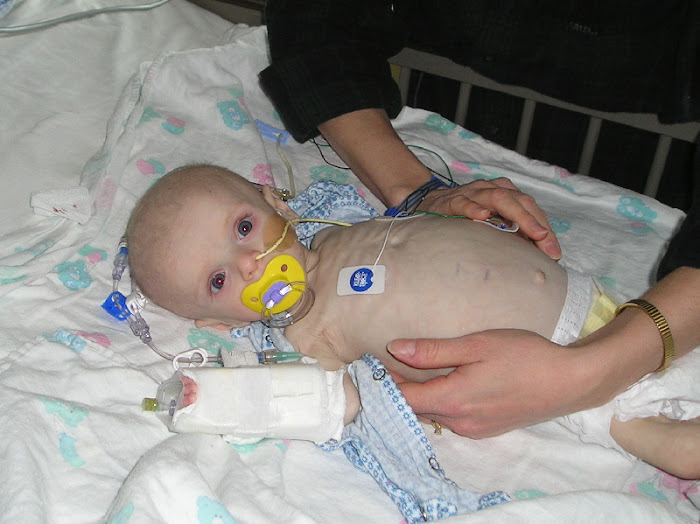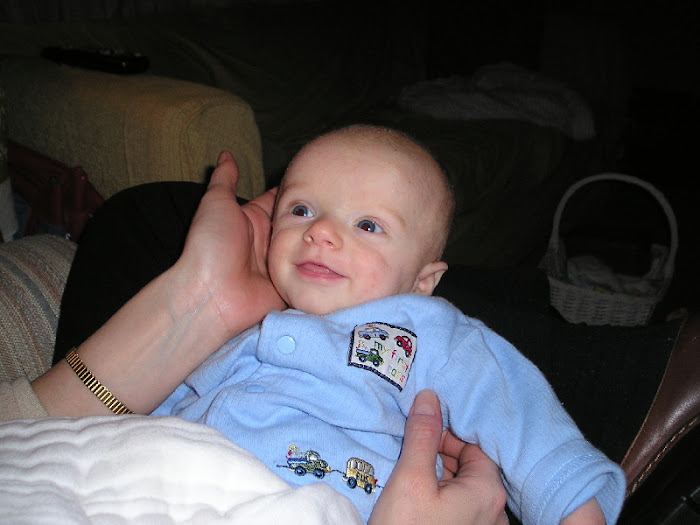Peter's PICC line has unfortunately dislodged on us... Sunday afternoon... two days before New Year's Day.
Peter was getting his usual PICC dressing change on his usual day, Sunday. But he decided that he had had enough of the dressing change faster than we could stop him from moving, and the PICC line moved out of its insertion site about an inch. The look on my face told the other children that things were not good and then I burst into tears. I called Dr. Kamin in Boston to see if he thought it had moved too far. He said we should get an x-ray to determine if the PICC had moved too far out. The local hospital said they didn't want to x-ray Peter because they didn't have a radiologist in house... Sunday afternoon... and they don't usually do children.
Long story made short, we ended up going to CHOP's ER. We got an x-ray taken about two hours after we got there and were told the PICC had indeed moved too far to use for TPN... could end up throwing a clot. Lots of phone calls to Dr. Kamin in Boston(what a dedicated doctor!) and talks with the ER and ER calling Interventional Radiology... go to Boston's IR? ,go inpatient at CHOP?, need a transfusion?, will anyone get worked up about Peter's current anemia (normal for him, but still abnormal), etc. So we drew a CBC just to see where that was and behold he was 8.2, up from the week before, so no transfusion! Boston was expecting 8 inches of snow, so that answered the question of driving up there from PA. And IR was double-booked for the entire next day and closed for New Year's Day, so it was pointless to stay in hospital... and actually we were glad to hear that, so it made the decision easy to come home and wait for an available IR appointment.
Now Peter is home on a make-shift concoction of electrolytes and sugar in IV form until he gets a new PICC placed this Wednesday at CHOP. Fortunately it should be able to be done outpatient and he should be in and out within about three to four hours from arrival to departure. The procedure should quick once he is in there, with light sedation, no intubation expected.
Peter has had this PICC line since October 2006, so I guess we can't complain too much. The timing stunk, but at least it didn't happen on Christmas!
Monday, December 31, 2007
Wednesday, December 19, 2007
Still improving
Peter still gets weekly labs, but his PICC line makes it painless for him. I always spend the rest of the day fretting about what the numbers will be. Usually hemoglobin is the main worry, as he continues to have bleeds from the fistula off and on. When his hemoglobin gets down to 7.0 or so he needs to get another blood transfusion.
This week the worry was more about what the other numbers would be, since last week's hemoglobin was 9.0 and he usually doesn't drop down to 7 within a week. Last week he showed us that he was holding onto fluid and that threw his albumin and sodium off, and he had some fluid building up in his legs. It seems that his fistula is not putting out as much fluid lately... which is a good sign, but in return we ended up needing to decrease the amount of replacement fluid we've been giving him.
The results of this week's labs are back. This week we seem more balanced in the fluid department and albumin is back up to 2.4 (still low, but better than 2.0) and sodium is normal. Direct bili stayed at 1.2 this week, as it did last week, and the total bili went up to 2.1 from 1.9. The discussion is whether this is due to addition of plain yogurt or not. We have been giving small amounts of milk as desired for months and thought the yogurt would also be alright, but we are going to cut it back from 3 to 5 tsp daily to just 1 tsp daily. Hopefully the bili's will continue to go downward consistently as they had been. Dr. Puder reminds us to be patient and not change things enterally until the direct bili gets to around 0.4.
The hemoglobin this week is 8.4, so if we can keep bleeds at bay, maybe we can avoid transfusing during Christmas week too. The fistula bleeds so much due to irritation and due to clotting ability still not being normal. That should improve as the liver improves. We are also experimenting with different ostomy products with the help of Children's Boston wound care nurse and some of our own trial and error. The fact that Peter is able to keep any ostomy appliance on his abdomen at all is quite remarkable - a good advertisement for the Convatec company indeed. He just folds himself right in half when he wants to get onto his tummy, and that is exactly where the fistula and that one ostomy appliance are. (He has two other ostomy bags too, but they don't get quite as taxed as they are more off to the sides.)
Peter knows his entire alphabet at age two and one month. He still doesn't talk, but you can ask him any letter and he'll find it. He learned the letters in about 3 months. Dr. Puder says the Omegaven babies seem to be very bright. I don't know if it is the Omegaven or the one-on-one care that he gets with home nursing. Regardless, knowing the alphabet at an early two years of age is definitely worth bragging about, even if Peter isn't walking or talking yet!
And though I don't write about it in every post, I never forget that the true source of all of Peter's progress, and our strength, is our good Lord. God is good and we are ever grateful. Merry Christmas to all of you who take the time to keep up with Peter's news.
This week the worry was more about what the other numbers would be, since last week's hemoglobin was 9.0 and he usually doesn't drop down to 7 within a week. Last week he showed us that he was holding onto fluid and that threw his albumin and sodium off, and he had some fluid building up in his legs. It seems that his fistula is not putting out as much fluid lately... which is a good sign, but in return we ended up needing to decrease the amount of replacement fluid we've been giving him.
The results of this week's labs are back. This week we seem more balanced in the fluid department and albumin is back up to 2.4 (still low, but better than 2.0) and sodium is normal. Direct bili stayed at 1.2 this week, as it did last week, and the total bili went up to 2.1 from 1.9. The discussion is whether this is due to addition of plain yogurt or not. We have been giving small amounts of milk as desired for months and thought the yogurt would also be alright, but we are going to cut it back from 3 to 5 tsp daily to just 1 tsp daily. Hopefully the bili's will continue to go downward consistently as they had been. Dr. Puder reminds us to be patient and not change things enterally until the direct bili gets to around 0.4.
The hemoglobin this week is 8.4, so if we can keep bleeds at bay, maybe we can avoid transfusing during Christmas week too. The fistula bleeds so much due to irritation and due to clotting ability still not being normal. That should improve as the liver improves. We are also experimenting with different ostomy products with the help of Children's Boston wound care nurse and some of our own trial and error. The fact that Peter is able to keep any ostomy appliance on his abdomen at all is quite remarkable - a good advertisement for the Convatec company indeed. He just folds himself right in half when he wants to get onto his tummy, and that is exactly where the fistula and that one ostomy appliance are. (He has two other ostomy bags too, but they don't get quite as taxed as they are more off to the sides.)
Peter knows his entire alphabet at age two and one month. He still doesn't talk, but you can ask him any letter and he'll find it. He learned the letters in about 3 months. Dr. Puder says the Omegaven babies seem to be very bright. I don't know if it is the Omegaven or the one-on-one care that he gets with home nursing. Regardless, knowing the alphabet at an early two years of age is definitely worth bragging about, even if Peter isn't walking or talking yet!
And though I don't write about it in every post, I never forget that the true source of all of Peter's progress, and our strength, is our good Lord. God is good and we are ever grateful. Merry Christmas to all of you who take the time to keep up with Peter's news.
Thursday, December 6, 2007
Inactivated on transplant list!!
We went up to Children's Hospital Boston for our very first outpatient visit! And we drove for the first time too! We live seven hours away from Boston, so it is quite a drive. Peter did amazingly well. We have previously had to go up via Medflight due to Peter's difficulty in travelling in a car without getting beside himself - never knowing if it was something wrong or a simple tantrum or what. Up until August he didn't ride in a carseat, but rather a make-shift car bed. So, seven hours in a carseat with only one long stop, and very few tears or complaints. Who could ask for more?
Dr. Kim, Dr. Kamin, Dr. Puder, and Dr. Lo all came in to see Peter. Everyone commented on how good he looks. And we have decided to make him inactive on the transplant list... the urgency for transplant seems to be gone. The liver injury appears to be halted, possibly reversing. With the liver cooperating now, we don't expect that he will suddenly nose-dive into illness as he would do if he were still declining in health of the liver. This is really amazing. There have been about 70 children pull out of liver injury on Omegaven at Children's Boston. We expect that Peter will follow in their tracks and continue in his improvement. He is apparently the first child to pull out of/halt the liver injury who has been as sick as he was for as long as he was.
We still have the bowel issues to deal with. We don't know if the bowel will work well enough to eventually come off TPN, but with the inflammation to the liver gone, we can soon begin to test the bowel. Since we don't know that the bowel will work, and we don't know if surgery to reconnect the bowel will be successful, and because Peter's liver was so sick for so long, we are for now just inactivating him. I have officially unpacked my bags that have been packed since August for when the transplant call came. We are a little nervous about our decision, but deep inside it seems right. Peter acts like he feels the best he has ever felt. He looks good and labs are good. We continue to pray and we thank God every day for his happy little self.
Dr. Kim, Dr. Kamin, Dr. Puder, and Dr. Lo all came in to see Peter. Everyone commented on how good he looks. And we have decided to make him inactive on the transplant list... the urgency for transplant seems to be gone. The liver injury appears to be halted, possibly reversing. With the liver cooperating now, we don't expect that he will suddenly nose-dive into illness as he would do if he were still declining in health of the liver. This is really amazing. There have been about 70 children pull out of liver injury on Omegaven at Children's Boston. We expect that Peter will follow in their tracks and continue in his improvement. He is apparently the first child to pull out of/halt the liver injury who has been as sick as he was for as long as he was.
We still have the bowel issues to deal with. We don't know if the bowel will work well enough to eventually come off TPN, but with the inflammation to the liver gone, we can soon begin to test the bowel. Since we don't know that the bowel will work, and we don't know if surgery to reconnect the bowel will be successful, and because Peter's liver was so sick for so long, we are for now just inactivating him. I have officially unpacked my bags that have been packed since August for when the transplant call came. We are a little nervous about our decision, but deep inside it seems right. Peter acts like he feels the best he has ever felt. He looks good and labs are good. We continue to pray and we thank God every day for his happy little self.
Thursday, November 8, 2007
Comments Enabled
Still new to blogging. I think now I have the settings set for comments if anyone wants to leave a message.
Wednesday, November 7, 2007
So we are saying no to transplant for now
Peter's bilirubin has dropped 21 points since we listed him in August! His CRP (C-Reactive Protein - an inflammatory marker) is normal for a few weeks now. Going by how the other Omegaven children have improved, we should see Peter's bilirubin hit normal within just a few more weeks. With a normal CRP and a normal bilirubin, we should be able to begin refeeding Peter and then see what his bowel can really handle since the liver inflammation should be gone. This is still all theory to some extent because none of the other children have pulled out of liver injury after this long. They have all gone on to liver/multivisceral transplant or, sadly, have died by this point. Peter is not just hanging on by a thread either. He has gotten remarkably stronger since the listing and has even started standing.
The transfusions still are frequent - every 3 to 4 weeks. The portal hypertension is probably still at play, as is the fragility of the enterocutaneous fistula and its proneness to bleed from the stoma site itself. The INR remains elevated, that is a bleeding number that would be better to be lowering at this point. The elevation of the INR and the low (but stable) albumin number may likely be due to his intestinal losses from the fistula, as opposed to the liver still being so sick. It is all hard to tell right now.
Peter is due to go for another check up in Boston in a few more weeks. We are actually going to drive him up vs Medflight, and we are going to be seen outpatient vs inpatient. Very exciting news.
The multivisceral/liver transplant call was one we would have accepted just two months ago when Peter seemed like he was not going to pull out. I hope we have made the right choice in saying no to transplant for now and at least seeing whether the bowel will work once the liver finishes the recovery it seems to be making.
In case anyone is wondering what changed after we listed him, we increased the dose of Omegaven by 11% since we hadn't adjusted the dose when Peter had gained weight. But probably more importantly, we pulled the feeding tube out. He was getting all he needed with TPN but we had trophic feeds going at 2mL an hour nonstop running through a sick bowel. Dr. Puder has seen with his studies that when the sick bowel is allowed to rest or to work less the bilirubin then begins to to down and the CRP goes down. The Omegaven allows the patient to have time for all of this to happen without the liver getting worse on TPN, and also seems to play a role in healing the liver with the omega 3s. Once those numbers are normal then the bowel can begin to be refed more aggressively in attempts to rehab the bowel. The liver injury does not seem to return once it has cleared. Peter's portal vein clot and his ever-draining bowel add additional complications into the picture making it unclear if Peter's course could follow that of so many of the other Omegaven children. We will see.
We have the most wonderful doctors at Children's Hospital Boston - Dr. Kamin, Dr. Kim, Dr. Puder. We are ever so grateful for their ongoing support. They never just "shelf" Peter as this continues on and on. They are respectful of our decisions and indecisions. They are genuinely nice people. What a true blessing!
The transfusions still are frequent - every 3 to 4 weeks. The portal hypertension is probably still at play, as is the fragility of the enterocutaneous fistula and its proneness to bleed from the stoma site itself. The INR remains elevated, that is a bleeding number that would be better to be lowering at this point. The elevation of the INR and the low (but stable) albumin number may likely be due to his intestinal losses from the fistula, as opposed to the liver still being so sick. It is all hard to tell right now.
Peter is due to go for another check up in Boston in a few more weeks. We are actually going to drive him up vs Medflight, and we are going to be seen outpatient vs inpatient. Very exciting news.
The multivisceral/liver transplant call was one we would have accepted just two months ago when Peter seemed like he was not going to pull out. I hope we have made the right choice in saying no to transplant for now and at least seeing whether the bowel will work once the liver finishes the recovery it seems to be making.
In case anyone is wondering what changed after we listed him, we increased the dose of Omegaven by 11% since we hadn't adjusted the dose when Peter had gained weight. But probably more importantly, we pulled the feeding tube out. He was getting all he needed with TPN but we had trophic feeds going at 2mL an hour nonstop running through a sick bowel. Dr. Puder has seen with his studies that when the sick bowel is allowed to rest or to work less the bilirubin then begins to to down and the CRP goes down. The Omegaven allows the patient to have time for all of this to happen without the liver getting worse on TPN, and also seems to play a role in healing the liver with the omega 3s. Once those numbers are normal then the bowel can begin to be refed more aggressively in attempts to rehab the bowel. The liver injury does not seem to return once it has cleared. Peter's portal vein clot and his ever-draining bowel add additional complications into the picture making it unclear if Peter's course could follow that of so many of the other Omegaven children. We will see.
We have the most wonderful doctors at Children's Hospital Boston - Dr. Kamin, Dr. Kim, Dr. Puder. We are ever so grateful for their ongoing support. They never just "shelf" Peter as this continues on and on. They are respectful of our decisions and indecisions. They are genuinely nice people. What a true blessing!
Monday, September 3, 2007
On top of the world
So Peter is acting like he just feels wonderful. He has accomplished the task of rolling onto his tummy and back onto his back over the last week. He is working on tummy-time play for twenty minutes at a time. He has been sitting in the highchair contentedly for an hour to an hour-and-a-half, either reading, gnawing on a piece of fruit (in a mesh bag of course, as to not clog up his G/J tube), or just watching the rest of us at the table.
His coloring is good this whole last week. He gets labs drawn tomorrow. We are prepared for a transfusion if need be, but if his behavior and coloring are actually telling us accurate information, then he should not need one again this week. Peter has fooled us all before though... looking just fine, but with labs that tell a different story.
I feel like I am the eternal optimist here, a characteristic that I would not necessarily have claimed myself to have prior to Peter's situation, but the increase in Omegaven and the removal of the enteral feeding tube quite possibly could have helped out his liver immensely. The enteral feeding tube may have been irritating to the very fragile bowel Peter has, and the feeds, though slow, were continuous and perhaps were also too much for him to handle. (Dr. Puder has discussed bowel stress as an added strain to an injured liver several times as we have discussed lab results.) The Omegaven dose for Peter went up by 11 percent about four weeks ago, which I think is a substantial amount when we are talking about a med that is given at 10mL/kg. He went from 100mL to 111.6 mL.
So tomorrow we will look at the lab results and see if Peter is doing as well as he looks, or if he is looking and acting well despite his illness. I do hear and read that with liver/intestine illness combined, the person can seem more well than someone who needs a liver alone, and then suddenly become quite ill. The tranplant listing process seems to accomodate for that by adding an additional 23 points to the listing score for the liver/intestine/multivisceral patients, as compared to a person waiting for a liver alone.
I'll keep you posted on Peter's labs.
**** UPDATE on Kawasaki and coronary arteries from August: Cardiology reviewed Peter's records and images from CHOP and CHB and it seems that Peter has large coronary arteries, but that they have not suddenly enlarged. With his INR elevated already he does not need any kind of anticoagulation. Whenver the INR returns to normal we will revisit the coronary arteries and see if we feel the need to anticoagulate with low-dose aspirin therapy or not. There is a risk of clots with large coronary arteries. We will reimage the coronary arteries at another time when he is put under anesthesia for another procedure, but for now the concerns are minimal and at bay.
His coloring is good this whole last week. He gets labs drawn tomorrow. We are prepared for a transfusion if need be, but if his behavior and coloring are actually telling us accurate information, then he should not need one again this week. Peter has fooled us all before though... looking just fine, but with labs that tell a different story.
I feel like I am the eternal optimist here, a characteristic that I would not necessarily have claimed myself to have prior to Peter's situation, but the increase in Omegaven and the removal of the enteral feeding tube quite possibly could have helped out his liver immensely. The enteral feeding tube may have been irritating to the very fragile bowel Peter has, and the feeds, though slow, were continuous and perhaps were also too much for him to handle. (Dr. Puder has discussed bowel stress as an added strain to an injured liver several times as we have discussed lab results.) The Omegaven dose for Peter went up by 11 percent about four weeks ago, which I think is a substantial amount when we are talking about a med that is given at 10mL/kg. He went from 100mL to 111.6 mL.
So tomorrow we will look at the lab results and see if Peter is doing as well as he looks, or if he is looking and acting well despite his illness. I do hear and read that with liver/intestine illness combined, the person can seem more well than someone who needs a liver alone, and then suddenly become quite ill. The tranplant listing process seems to accomodate for that by adding an additional 23 points to the listing score for the liver/intestine/multivisceral patients, as compared to a person waiting for a liver alone.
I'll keep you posted on Peter's labs.
**** UPDATE on Kawasaki and coronary arteries from August: Cardiology reviewed Peter's records and images from CHOP and CHB and it seems that Peter has large coronary arteries, but that they have not suddenly enlarged. With his INR elevated already he does not need any kind of anticoagulation. Whenver the INR returns to normal we will revisit the coronary arteries and see if we feel the need to anticoagulate with low-dose aspirin therapy or not. There is a risk of clots with large coronary arteries. We will reimage the coronary arteries at another time when he is put under anesthesia for another procedure, but for now the concerns are minimal and at bay.
Wednesday, August 29, 2007
More ups and downs
This week the good news is that Peter obviously feels good - playful, content, "talkative." Also, his hgb was 9.6 and hct was 29 - NO TRANSFUSION NEEDED this week despite the four he needed over the three weeks before. He really pleasantly surprised us with his blood count, especially after seeing so much blood loss out his four drainage tubes over the last week.
However, our ups with Peter so often seem to have a down too. The echocardiogram that was done in (Children's Hosp Boston)CHB last week shows that Peter has enlarged coronary arteries now. The thought is that he may have had Kawasaki Disease on top of all of the issues he has from the AVM and perforated bowel and liver disease and portal clot. I am REALLY having a hard time believing this. When Peter was at Children's Hospital Philadelphia (CHOP) and his white count was 120,000 and no one could believe that an AVM could cause it, one of the countless diseases/conditions he was tested for was indeed Kawasaki. The discussion of that died within a day of receiving IVIG for the possiblity of Kawasaki and the next list of diseases/conditions were posed. I am going to be contacting CHB tomorrow to discuss all of this.
There is always something going on with Peter. Really... a fever, bleeding, a last minute problem of no transportation to get to the hospital, a new vac machine that intermittently turns itself up to the highest setting or off, a cracked PICC line (that only happens at CHOP about once every two years), missing medical records, nutrition labs that come back with values that are typically not seen with TPN children, etc. He must certainly have a very special role to play in this life to command this much attention as a child without even trying!!
However, our ups with Peter so often seem to have a down too. The echocardiogram that was done in (Children's Hosp Boston)CHB last week shows that Peter has enlarged coronary arteries now. The thought is that he may have had Kawasaki Disease on top of all of the issues he has from the AVM and perforated bowel and liver disease and portal clot. I am REALLY having a hard time believing this. When Peter was at Children's Hospital Philadelphia (CHOP) and his white count was 120,000 and no one could believe that an AVM could cause it, one of the countless diseases/conditions he was tested for was indeed Kawasaki. The discussion of that died within a day of receiving IVIG for the possiblity of Kawasaki and the next list of diseases/conditions were posed. I am going to be contacting CHB tomorrow to discuss all of this.
There is always something going on with Peter. Really... a fever, bleeding, a last minute problem of no transportation to get to the hospital, a new vac machine that intermittently turns itself up to the highest setting or off, a cracked PICC line (that only happens at CHOP about once every two years), missing medical records, nutrition labs that come back with values that are typically not seen with TPN children, etc. He must certainly have a very special role to play in this life to command this much attention as a child without even trying!!
Wednesday, August 22, 2007
Listed for Transplant
Though this is our first posting on a "site" about Peter, we are starting from where we are now. We'll post some history later on.
Peter and I are home from Children's Hospital Boston from his routine three day visit, that this time turned into a 14 day visit. While Peter is still "healthy" enough to go home again with private duty nursing continuing to help, we are anticipating transplant to be sometime soon. Peter was so happy to be home! He wanted to be surrounded by his toys and hold them all at once. Lots of smiles for his siblings and from his siblings!
We have been waiting for Peter to recover from his liver and bowel injuries since June 2006. He still remains on TPN and Omegaven and has 3 urimeter bags, one wound vac, two ostomies, one fistula, and private duty nursing to help us out with all of his needs. (UPDATE: we got rid of the wound vac and added another ostomy bag with urimeter... so now we see three ostomies and 4 urimeter bags. It has simplified his care some though.)
As we sent out in our email, on August 10, 2007 we listed Peter for a multivisceral transplant at Children's Hospital Boston. This will be a transplant of the liver and intestine. It will also include the pancreas, lower 2/3 of the stomach, and spleen, as is fairly commonly done in a multivisceral transplant, and necessarily so for Peter due to all of the injury that occured within the bowel. This operation will also get rid of the portal vein clot that has made Peter's illness all the more complex. It will also get rid of the bags, fistula, transfusions, nursing needs, and restore Peter back to a normal activity level. With his current set up he is quite weighed down and physical activity is limited.
This had been a difficult decision for us up until now, as we had been putting so much hope into Peter's recovery and ability to eventually pull out of this mess himself. The Omegaven that we originally came up here for has now helped 49 (and counting) babies pull out of TPN (IV nutrition) liver injury, but Peter's liver injury is also due to the original arteriovenous malformation and the portal vein clot, making recovery without transplant not likely.
The difficulty of deciding whether to list Peter or to continue to wait and see if he heals himself seemed to lift away this week. Meeting three other multivisceral transplant children and their families has made us feel that this is truly a hopeful operation that holds real promise in restoring Peter to health.
(FYI - For anyone who is following the progress of Omegaven as a promising lipid for prevention of TPN-related liver injury, the FDA has recently given a million dollars in grant monies to continue Omegaven testing. It does seem to hold much promise for prevention and for reversal of TPN liver injury... but of course Peter is going to be one of the exceptions most likely due to the portal clot. There are several other hospitals now incorporating Omegaven into their TPN regimes. Children's Hospital in Pittsburgh, where many TPN-related-liver-injury transplants are performed, is one of those hospitals now using Omegaven too, after seeing repeated success in the patients they sent to Boston for Omegaven.)
Please keep Peter in your prayers. The prayers have done wonders for him so far. Despite his tubes, illness, hospitalizations, he is a strong little boy. As Kathryn's grandmother put it, "Peter just doesn't know he is sick." And as his sister put it, "I think Peter is very brave. I think he is going to be the bravest of all the brothers."
Keeping faith in God and knowing that God is good,
Kathryn and Chris
Peter and I are home from Children's Hospital Boston from his routine three day visit, that this time turned into a 14 day visit. While Peter is still "healthy" enough to go home again with private duty nursing continuing to help, we are anticipating transplant to be sometime soon. Peter was so happy to be home! He wanted to be surrounded by his toys and hold them all at once. Lots of smiles for his siblings and from his siblings!
We have been waiting for Peter to recover from his liver and bowel injuries since June 2006. He still remains on TPN and Omegaven and has 3 urimeter bags, one wound vac, two ostomies, one fistula, and private duty nursing to help us out with all of his needs. (UPDATE: we got rid of the wound vac and added another ostomy bag with urimeter... so now we see three ostomies and 4 urimeter bags. It has simplified his care some though.)
As we sent out in our email, on August 10, 2007 we listed Peter for a multivisceral transplant at Children's Hospital Boston. This will be a transplant of the liver and intestine. It will also include the pancreas, lower 2/3 of the stomach, and spleen, as is fairly commonly done in a multivisceral transplant, and necessarily so for Peter due to all of the injury that occured within the bowel. This operation will also get rid of the portal vein clot that has made Peter's illness all the more complex. It will also get rid of the bags, fistula, transfusions, nursing needs, and restore Peter back to a normal activity level. With his current set up he is quite weighed down and physical activity is limited.
This had been a difficult decision for us up until now, as we had been putting so much hope into Peter's recovery and ability to eventually pull out of this mess himself. The Omegaven that we originally came up here for has now helped 49 (and counting) babies pull out of TPN (IV nutrition) liver injury, but Peter's liver injury is also due to the original arteriovenous malformation and the portal vein clot, making recovery without transplant not likely.
The difficulty of deciding whether to list Peter or to continue to wait and see if he heals himself seemed to lift away this week. Meeting three other multivisceral transplant children and their families has made us feel that this is truly a hopeful operation that holds real promise in restoring Peter to health.
(FYI - For anyone who is following the progress of Omegaven as a promising lipid for prevention of TPN-related liver injury, the FDA has recently given a million dollars in grant monies to continue Omegaven testing. It does seem to hold much promise for prevention and for reversal of TPN liver injury... but of course Peter is going to be one of the exceptions most likely due to the portal clot. There are several other hospitals now incorporating Omegaven into their TPN regimes. Children's Hospital in Pittsburgh, where many TPN-related-liver-injury transplants are performed, is one of those hospitals now using Omegaven too, after seeing repeated success in the patients they sent to Boston for Omegaven.)
Please keep Peter in your prayers. The prayers have done wonders for him so far. Despite his tubes, illness, hospitalizations, he is a strong little boy. As Kathryn's grandmother put it, "Peter just doesn't know he is sick." And as his sister put it, "I think Peter is very brave. I think he is going to be the bravest of all the brothers."
Keeping faith in God and knowing that God is good,
Kathryn and Chris
Subscribe to:
Comments (Atom)

